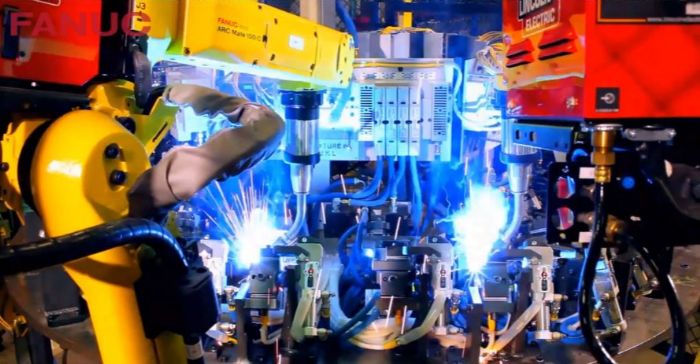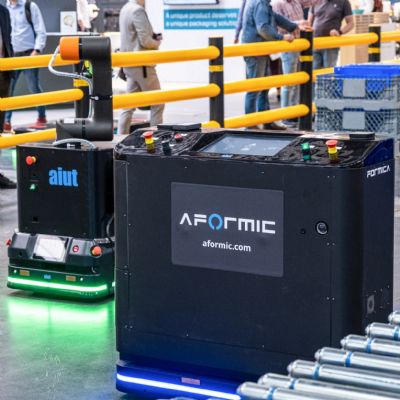“Some designs are using existing ICE-vehicle components and structures, and adapting those to BEVs,” Scherler explains. “In other cases, designs from the ground up are specific to BEVs. Differences between these two approaches affect the amount of welding required. BEV-specific designs may not require some of these welds.”
Why?
“An existing design converted to hold battery packs and employ other features may require the welding of clamps and brackets, and additional frame members,” he says. “BEV-specific designs do away with these needs.”
While the amount of welding may change, so, too, may the types of processes employed.
“Our robotic welders perform a lot of arc welding on current frames,” says Scherler, “but different components, including what we see in BEVs, require laser-hybrid and friction-stir welding, which aren’t as common as arc welding. Suppliers entering the BEV area will need to know more about these welding processes.”
Robotic welding-wise, what BEV applications is Scherler seeing today?
“The two most common welded-on components we see today are frames, or skateboards in the case of trucks, and battery boxes,” he says. “Again, if it is an existing frame being adapted for a BEV, that’s where we see clamps and brackets welded on to hold the battery box. Often, the frames have not been designed to hold the battery boxes, and must be reinforced. This means placing much more weld on the structure.
“And, cases for batteries must be hermetically sealed,” Scherler continues. “This is where a manufacturer most likely uses laser-hybrid or friction-stir welding rather than arc welding.”
No Letup in Lightweighting
Just as with ICE vehicles, BEVs also incorporate lightweighting wherever possible—a big help in getting the most juice out of batteries.
“Lightweighting often means pulling in unique materials such as advanced high-strength steel and aluminum,” says Scherler. “Aluminum requires a different welding approach than steel. Some welding processes are more ideal for aluminum than steel, and vice-versa. Manufacturers must be familiar with the different materials and what welding processes work best on what material.”
Most manufacturers, according to Scherler, prefer to stick with a traditional gas-metal-arc-welding (GMAW) process, because it's relatively cheap and easy. For the reasons described above, GMAW may not fit the bill.
“But, incorporating some of these other processes requires a significant increase in capital-equipment costs, which manufacturers must consider,” he says.
Process Monitoring Vital
The increased use of various materials and various welding processes, along with needed BEV features such as hermetically sealed battery boxes, will necessitate a greater reliance on process monitoring and quality control than with ICE vehicles.
“Process monitoring will become even more critical,” explains Scherler. “In traditional automotive manufacturing, process monitoring has tended to focus on, say, safety welds, where components must remain joined in the event of a crash. The same holds true for BEVs, but there’s more to monitor. Sealing a battery box, for instance, requires the assurance of a good weld without porosity or defects. This all must be monitored.”
The need for process monitoring fits in well with robotic systems, according to Scherler. For its part, Fanuc provides the mechanical robot unit and controller, with integrated third-party welding systems.
“An advantage in a robotic-welding application: The robot, during the weld process, can provide information relative to the location of the welds,” he says. “And, with the robot collecting information from the welding equipment, a manufacturer has data on any weld defects along with their locations. A robotic-welding system provides good indication of weld quality. In any case, post-weld inspection, through a laser vision tracking system perhaps, may be required to ensure quality in critical BEV applications such as weld sealing of the battery cases.”
Fanuc has been working on process-control optimization for robotic welding, Scherler reports, specifically “the interface to the weld-process equipment to optimize the control of that equipment. Using laser welding as an example, that process provides much faster travel speed than arc welding. When traveling around corners or making other moves during laser welding, we want to ensure precise control of robot motion. The robot must be able to control the laser-welding process and keep it tightly in sync with robot motion to provide quality welds.”
The same holds true for robotic friction-stir welding, which requires much more force from the robot than other processes.
“The robot must monitor the force feedback from the weld head to ensure the correct amount of pressure, and make sure it has control of movement along the weld path,” says Scherler. “Collecting information—the feedback from the process equipment—and saving it to a location where the user can easily monitor or generate reports as needed, allows the manufacturer to maintain weld quality and desired production rates.” MF
See also: FANUC America, Inc.
Technologies: Pressroom Automation, Welding and Joining







 Longer term, there’s no stopping BEVs, according to most experts. By 2040, according to multiple studies, more than half of all new light-vehicle sales worldwide will be of the electric variety. With that in mind, automotive stakeholders are seriously researching the technology and its down-the-road potential, as evidenced by the
Longer term, there’s no stopping BEVs, according to most experts. By 2040, according to multiple studies, more than half of all new light-vehicle sales worldwide will be of the electric variety. With that in mind, automotive stakeholders are seriously researching the technology and its down-the-road potential, as evidenced by the 
 Video
Video